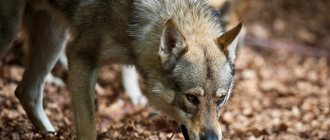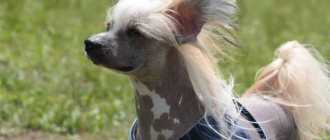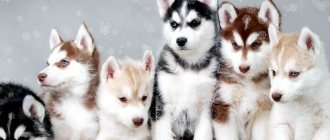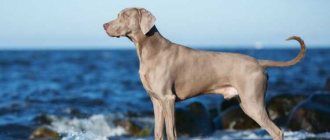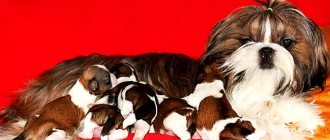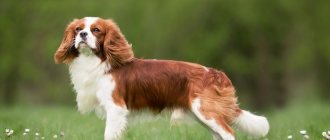- Wild animals
- >>
- Mammals
The beast with such a terrifying name - wolfdog , is a hybrid of a wolf and a dog. It is extremely rare in the wild - only if a wolf and a stray dog are mated, which is extremely rare. A wild wolfdog is an extremely dangerous animal, because it combines the strength and ferocity of a wolf, but at the same time is not at all afraid of people. Fortunately, a wolf-dog is usually born in the event of a planned mating of a dog (several breeds are used) and a gray wolf.
Origin of the species and description
Photo: Volkosob
Initially, wolf-dogs were bred by employees of one of the military institutes by crossing gray wolves and German shepherds (the first litter was the result of crossing the tamed she-wolf Naida with a “titled German” named Schnapps).
Before this, experiments on breeding these animals were repeatedly carried out, but the experience of Perm scientists is considered the most successful. Cynologists unanimously confirmed the fact that the so-called “Perm” wolf-dogs had much more advanced sense of smell, intelligence and endurance than all other wolf-dogs (not to mention wolves or dogs).
Video: Wolfdog
Moreover, this conclusion has been repeatedly confirmed in practice - in order to find a person in an unlit enclosed space, the Perm wolfdog needed 20 seconds. For comparison, the previous record was set by a German shepherd, and it took her 4 minutes to solve a similar problem.
In the late 2000s, the border troops of the Russian Federation made attempts to gain practical benefits from breeding wolf-dogs - a new type of animal was proposed to be used to protect the Russian border with Mongolia and China. The project was of great importance because the FSB border department was responsible for its implementation. But after 6 years the project was closed (the reasons for its failure are classified).
In 2022, the Finns attempted to implement a private project to breed wolf-dogs, using the work of Perm dog handlers. However, the Finnish government categorically opposed this, passing a law prohibiting the import, breeding and sale of wolf dogs. The Minister of Agriculture motivated this decision by the struggle to preserve the gray wolf population, but no one knows what the reasons for this decision actually were (perhaps, with the exception of a very narrow circle of people).
But in Russia, breeding of wolf-dogs was stopped only at the state level - private nurseries began to actively practice mating dogs with domesticated wolves. Moreover, not only German shepherds, but also other dog breeds were used for this purpose. Moreover, not 50% of hybrids with wolf blood, but even lower, began to be considered wolf-dogs. That is, a mixed breed born as a result of mating a dog with a wolf-dog also began to be considered a wolf-dog (with the mention of the prefix F3).
Buying a wolf-dog in the Russian Federation is not a problem, because officially these animals are not considered particularly dangerous, requiring any specific conditions of detention. Formally, you can purchase such an animal (without breaking the law) even while living in an apartment. And it will cost very little - a cute F2 puppy will cost 10-15 thousand rubles, and for a more serious wolf-dog (F1) you will need to pay the breeder 17-18 thousand rubles.
Famous dog breeds are descendants of wolves
There are many breeds of dogs similar to wolves. Some of them are well known, including to the general public. Information about other species can only be obtained in narrow cynological circles and on specialized websites.
You can get acquainted with the main breeds of wolfdogs below:
Alaskan Malamute
It is believed that the Alaskan Malamute is a sled dog that was one of the first domesticated by humans. These are direct descendants of wolves. As the name suggests, the place of origin of these animals is Alaska, USA. An interesting fact is that the Malamute has been recognized as the symbol of the mentioned American state since 2010.
The breed was recognized by the FCI in 1963, group 5, section 1 – Nordic sled dogs.
The main purpose of the dog is to work in a harness. Unusually strong, hardy Malamutes do an excellent job with their main task. The structure of the skull and croup strongly resembles the constitution of the polar wolf. But the size of the Malamute is smaller than that of its ancient brother. The male's height at the withers does not exceed 63.5 cm, weight - no more than 38 kg.
- Alaskan Malamutes are incredibly friendly and sociable pets.
- Despite their large size, they are not at all suitable for protecting a home and territory.
- Representatives of the breed are strongly attached to humans and are distinguished by a calm and good-natured disposition.
- They should not be left alone for long.
The original feature of the Malamute is that they do not bark, but make sounds similar to grumbling.
The price for Malamute babies with a good pedigree ranges from 100-120 thousand rubles.
Siberian Husky
Beloved by many, this cheerful and unusually friendly dog has a 3,000-year history. The sled dog was used to transport people and cargo in the Russian northern and Far Eastern territories inhabited by the aborigines - the Chukchi, Eskimos, Evenks, Koryaks and others.
During the “gold rush”, when Alaska was sold to the United States by the Russian Empire, the breed was actively used and developed by the Americans. They achieved significant success in breeding and established a certain standard in 1930.
The breed was recognized by the FCI in 1966, group 5, section 1 – Nordic sled dogs.
The Siberian Husky is a medium-sized dog. Male height is up to 60 cm, weight is up to 28 kg. Bitches are usually 10 cm shorter and 5-7 kg lighter.
- Huskies are exceptionally intelligent and are considered excellent human companions.
- Not suitable for slow, inactive people, as they prefer to be on the move most of the day.
- They have high performance characteristics and require constant physical activity.
- They are not used for official purposes, as they are difficult to train and can be wayward.
- An ideal option for active activities is a sled; they have no equal in this sport and entertainment.
Today, huskies are very common in Russia; a puppy with a pedigree can be bought in an official nursery for a price of 15,000 rubles.
Appearance and features
Photo: What a wolfdog looks like
Despite the well-founded stereotype of a combination of courage, aggressiveness, endurance and willfulness, wolf-dogs (like any other animals) are very different from each other in character. Moreover, the decisive role in this case is determined by the percentage of wolf blood - the descendants of F2-F3 will be more similar in their disposition to good-natured malamutes, huskies and huskies. On the other hand, in one litter there are often both socially adapted, sociable puppies and shy individuals who are unsociable from birth.
All these points are determined by the genetic heritage of the parents and, of course, upbringing. It is for this reason that getting a wolf-dog is recommended only for those people who already have experience in training large and aggressive breeds of dogs. With the proper approach to education, you can turn a formidable wolf-dog into a reliable friend and devoted protector.
Moreover, wolf-dogs, raised from childhood together with other dogs, then get along well with them. But in most cases, they establish their dominance in the “pack”. If a wolf-dog does not show any manifestations of neophobia - fear of everything new, then it will be very easy with him in the process of education and socialization. Such wolf-dogs are unusually curious, active and affectionate.
Now you know what a hybrid of a wolf and a dog looks like. Let's see where wolf-dogs live.
Where does the wolfdog live?
Photo: Wolfdog
If we talk about a crossbreed between a dog and a wolf born in the wild, then most likely its habitat will be a forest belt located not far from the city limits. Or some other smaller settlement. The reason for this is trivial - in a deep forest there is no place for a pack of stray dogs to come from, and if any hunting dog gets lost, it is unlikely that he will be ready to mate with a wolf. Domestic dogs simply cannot survive in such conditions, not to mention the possibility of producing viable offspring from an animal belonging to a different species.
The domestic wolf-dog prefers to live on the property, run around the perimeter and scare away uninvited guests with its howl (unlike wolves, wolf-dogs bark beautifully, but a drawn-out wolf howl has a much more frightening effect, you must agree). A wolf dog can also live in an enclosure - but only at night it must be released into freedom (for a walk around the area).
F2 hybrids can also get along in a city apartment - only the neighbors and their dogs will be put into a stupor by the sight of such a beast. Even if he does not show any aggression towards them, dogs intuitively sense wolf blood, and on a subconscious level they are afraid of wolf-dogs.
But a wolfdog cannot make a chain dog under any circumstances - he is too freedom-loving. The animal will not accept such an attitude towards itself. This is not the right breed. The opposite principle is also fair - when going for a walk with a wolfdog, you must always keep it on a leash (even if the animal follows all your commands exactly). Why is that? The problem is that an animal, having felt the charm of wild nature, can run away and return only after it has had its fill.
Key points in training
- Training a Wolf Dog is not difficult. They are very intelligent and quickly remember all commands, and if it was initially shown that the owner is in charge, then the dog will be the most loyal and very obedient.
- As soon as the puppy gets into the house, it is necessary to immediately show who the leader is. This breed has a terrible habit of dominating its owner. This behavior must be stopped immediately so as not to lose control over the dog.
- Read about how to properly train a dog in the article: “Training a puppy: effective methods from dog handlers, learning commands at home.”
It is better to give the puppy for training to a professional dog handler. He will use a special method to motivate the dog to follow commands.
What does a wolfdog eat?
Photo: Wolfdog hybrid of a wolf and a dog
Regarding nutrition, the diet should include everything that any large dog receives. The exception is raw meat (meat, not bones or trimmings). Dogs are rarely given such a delicacy - given the appetites of four-legged pets and the current economy, not everyone can afford such a luxury, so minced meat, veins, liver or lung are added to dog food.
Wolf dogs need meat, and only raw meat. Yes, for the sake of satiation, you can give your pet pearl barley porridge with the addition of fish oil and pieces of liver - he will be incredibly happy to receive such a “dish”, but snacks should contain pieces of raw meat. Not poultry - just meat, richly flavored with fresh blood (lamb is the ideal option, but the wolf dog remembers the aroma of the blood of a freshly killed lamb).
The rest of the menu is no different from the dog menu. By-products with porridge (pearl barley, buckwheat, barley are suitable), dairy (cottage cheese must be given - at least puppies need it), as well as complexes of vitamins and minerals. Separately (up to a year) you need to give tableted calcium - for tooth growth.
Interesting fact: Contrary to logic, the favorite delicacy of ferocious wolfdogs is not fresh meat with blood, but store-bought sweets! Animals simply go crazy over marshmallows, cookies, sweets and pies. But giving them such treats is strongly discouraged - consuming these products has a detrimental effect on the condition of the teeth.
Health
Before buying a wolf-dog puppy, special services are interested in its health. The discovery was that the hybrid has high immunity and almost perfect health. It will survive in almost any habitat, adapting to anything. Therefore, the military takes four-legged animals with them to anomalous, radioactive and other zones.
Diseases, if they appear, disappear in wolfdogs in a matter of days, without relapses. So far, only rabies is fatal to them.
There are disputes on this issue between dog handlers from different countries. To date, it is not known whether a regular rabies vaccine helps hybrids, and a special one has not been invented. Some believe that this is not done intentionally to reduce the possibility of ordinary breeders keeping wolf dogs.
Features of character and lifestyle
Photo: Wolfdog breed
Breeders involved in breeding wolf-dogs convince their clients that a hybrid of a dog and a wolf is a real person, and not just a pet! This animal is many times smarter and more sensitive than all existing dog breeds. Wolfdog is a real telepath, he perfectly senses any person even at a distance, and knows the owner’s character (in the literal sense of the word) by heart. A properly raised wolf dog shows sincere affection towards its owners.
The beast is very affectionate, peaceful and patient - unquestioning submission to the leader (in the case of a person, this role can only be assigned to the owner, no equality), his deep respect and veneration is transferred to the beast from the wolves. But it’s difficult to say anything specifically about strangers and dogs. Everything is determined by the degree of perception - some people treat everyone normally, while others make contact only with the owner and are wary of strangers.
Interesting fact: Wolf dogs (all of them, both males and females) treat women much better than men. No one has yet found an explanation for this feature.
A timid wolf-dog, having found itself in an unfamiliar place, begins to be afraid of everything, does not listen and does not follow the commands given to it. But even such an animal can be taught the simplest commands and rules of life in the house. You just need to earn his trust and under no circumstances show weakness. For these animals there is no concept of “equality”. They perceive only the rigid “superior-subordinate” system, and nothing else.
Moreover, the slightest manifestation of fear will be immediately recognized by the wolf-dog - even if the owner does not show himself in any way. They feel people's emotions and understand everything perfectly without words, intonation or gestures. Although during training you cannot do without it. You need to teach your wolf-dog the simplest commands starting from 1.5-2 months. To consolidate the results, it is recommended to periodically repeat and “polish” the developed skills.
Distinctive features
The wolfdog differs from both the dog and the wolf . Representatives of this breed are very similar in appearance to a wolf, but in their obedience and devotion to humans they are similar to domestic dogs. Wolfdogs are smaller in size than a wolf, but larger than a dog. This breed combines all the traits of its parents equally:
- Size and weight: male – 60 cm and 50 kg; female – 55 cm and 40 kg.
- Head: elongated, proportional to the body.
- Eyes: almond-shaped, amber or light brown in color.
- Ears: triangular, protruding, medium size.
- Nose: developed, wide nostrils, color only black.
- Neck: dry, at an angle of 40˚.
- Paws: The front legs are straight and narrowly set, the paws are turned out, high, muscular.
- Torso: fit, muscular.
- Tail: set high, reaching to the metatarsus, thick.
- Coat: thick, with undercoat.
- Color: wolf (from light gray to dark, brown and black).
Social structure and reproduction
Photo: Wolfdogs
Regarding reproduction - in principle, wolves, like dogs, can reproduce in captivity (for this it will be enough to provide each pair with a separate enclosure). But breeding mestizos in captivity is very problematic. Why is that? The difficulty is that wolves are monogamous (monogamous, preferring only one female and remaining “faithful” to her throughout their lives), therefore, under unfavorable circumstances, they can easily reject or even kill a dog.
The reason may be a banal “inconsistency with ideas about beauty.” Or simply a lack of acquaintance before mating. Moreover, only a wolf (or a wolfdog, if we are talking about breeding F2 offspring) chooses a female suitable for mating. What is most unpleasant is that males most often choose not those females with whom they would make the best wolf-dogs.
Interesting fact: The best hybrids were obtained in those pairs where the male wolf was loyal to humans, had balance, but was not cowardly. It is enough for a bitch to have a good psyche and exterior.
It makes sense to dwell separately on the dog breeds used to breed wolf-dogs.
So, the following are subject to crossing with wolves:
- Saarloos wolf dog;
- Czech wolfdog;
- unrecognized breeds.
Of the latter, the Perm wolf dog is the most popular - despite the official cessation of breeding these dogs for the needs of the army and border service, private breeders are actively crossing German shepherds and wolves, obtaining very decent results.
It is impossible not to dwell on the numerous hybrids unrecognized throughout the world - many of the representatives of these breeds have become reliable guards of households and family favorites.
For example:
- Russian Wolfhund - bred by crossing a black Canadian wolf with a Malamute;
- Russian Woland - a cross between a husky and a wolf;
- Haskovolves;
- Swisswulf.
Less successful examples of breeding wolfdogs include the Russian dog Sulimov - the breed is a cross between a jackal and a husky, the American Wolfdog, the Italian Lupo and the Kunming breed bred by Chinese dog handlers.
Natural enemies of the wolfdog
Photo: What a wolfdog looks like
Wolf dogs raised in captivity show strong aggression towards almost everyone - they cannot tolerate wolves, dogs, or people. Wolf-dogs gathered in a pack are especially dangerous. Packs of these animals can easily attack even a group of armed people, showing rare ferocity and detached courage. They are not afraid of gunshots, screams, flames or smoke.
Therefore, the wolf-dogs themselves, living in the wild, can safely be called enemies of all living things - packs of mestizos attack even such large animals as elk, wild boar or bear. They are also dangerous because they retain amazing sensitivity to various kinds of poisons - the wolf dog will not even sniff the bait that an ordinary dog would swallow without a second thought.
A properly raised and trained domestic wolf dog will become “another member of the family” - like huskies and malamutes, these animals get along well in the family. But at the same time, the wolf-dog will always remain an unsurpassed guard (note that most often these animals keep watch in pairs). And if an uninvited guest, if discovered by a dog, first hears a loud bark and roar, then the wolfdog in this case will not make a sound, attacking from behind.
Wolf dogs are pack animals, so they easily get along with other dogs in the same territory. In order to eliminate any possibility of misunderstandings between your pets, it makes sense to buy and raise them together. Then they will get used to each other and begin to consider themselves members of one pack, the undisputed leader of which can only be the owner. Otherwise, it will be an uncontrollable pack, the presence of which will become dangerous for people.
